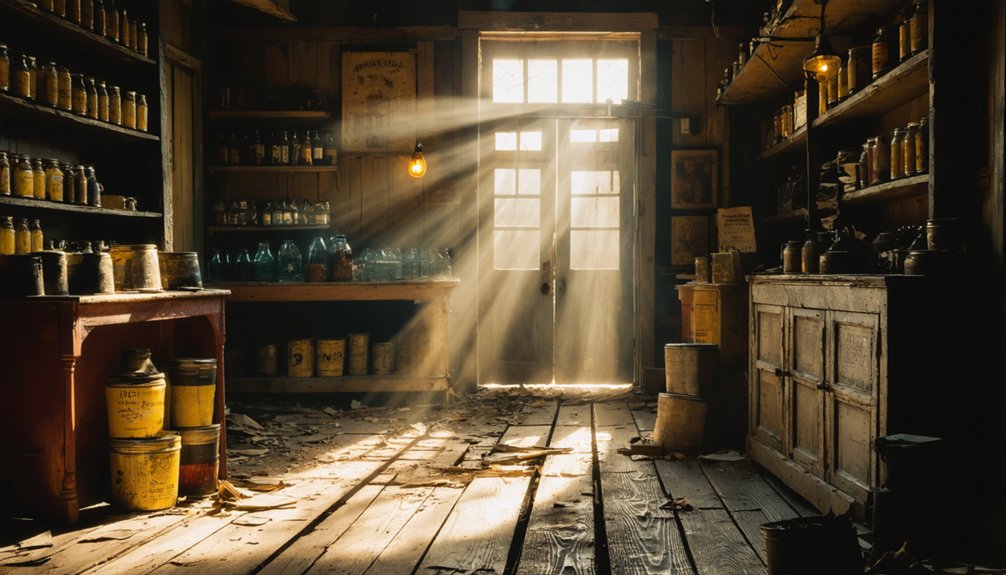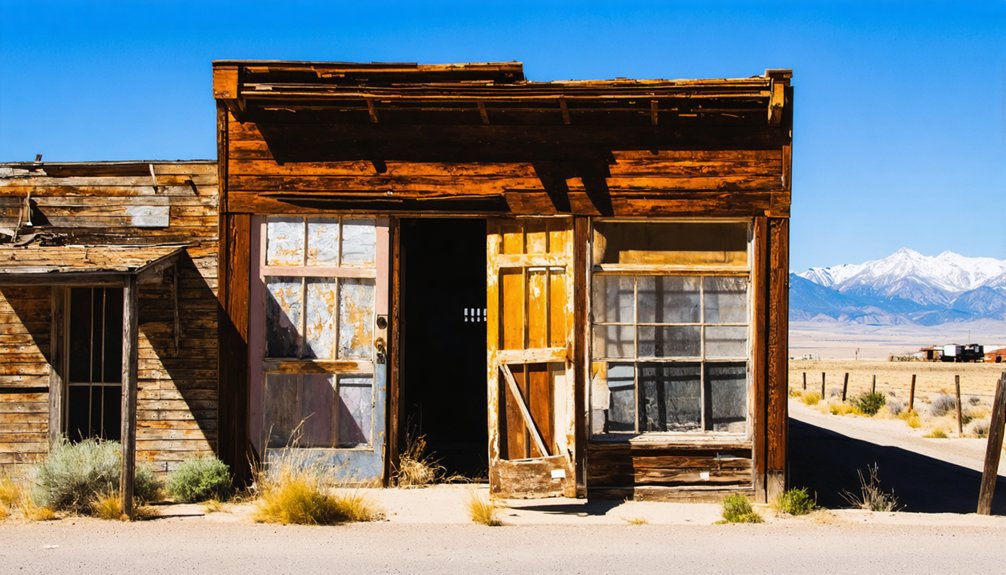Dallas was a Colorado boomtown established in 1879 during the silver rush in Unaweep Valley. Originally called “Unaw,” then “Gold City,” it thrived as a mining community with 100-200 residents at its peak. The town suffered from economic challenges, a major postal scandal, and ultimately declined as Ridgway rose. Today, you’ll find only scattered ruins, crumbling stone walls, and weathered foundations—silent witnesses to Colorado’s vanished mining era.
Key Takeaways
- Dallas, Colorado was established in 1879 during the silver rush in Unaweep Valley and later renamed from “Gold City” after a significant gold discovery.
- The town reached a peak population of 100-200 residents and was formally incorporated in 1884 despite lacking institutions like schools or churches.
- Mining operations evolved from silver and gold to include copper, vanadium, and molybdenum, using advanced techniques including hydraulic mining.
- A major postal scandal involving mail theft, delays, and federal investigations contributed to the town’s decline.
- Today, only scattered ruins and crumbling foundations remain, accessible via unpaved roads with no amenities or guided tours available.
The Birth of a Mining Boomtown (1879)
As the golden hues of the Colorado silver rush painted the landscape in 1879, Dallas emerged from the rugged terrain of the Unaweep Valley, transforming from chaotic mining attempts into a methodically planned settlement.
When initial unorganized mining techniques failed to yield results, settlers pivoted toward strategic community planning.
The Dallas Mining Company formed to conduct systematic mineral investigations, replacing haphazard prospecting with organized efforts.
Named after Vice President George M. Dallas, the town signified a commitment to permanence rather than transient extraction.
The settlement initially called “Unaw” was renamed to “Gold City” as rich placer gold was discovered, attracting a surge of prospectors to the area.
Unlike Dallas, other mining districts such as Cerrillos were established with standardized claim sizes measuring 1,500 feet along lode veins and 150 feet on either side.
Gold Fever: Mining Operations in the Unaweep Valley
While explorers had glimpsed Unaweep Valley’s mineral potential as early as 1875, the true mining frenzy began when systematic operations replaced haphazard prospecting efforts.
The initial mineral discoveries included impressive copper veins up to 20 feet wide with 10% copper content, along with silver, gold, and other valuable ores.
Astonishingly rich copper deposits—veins stretching 20 feet across with 10% purity—accompanied silver and gold throughout the region.
You’d find miners drilling and blasting rock faces using steam-powered hoists and air compressors to extract these treasures. Captain James Anderson settled in the area in June 1883 and became a prominent figure in local mining development.
By 1888, the Lone Tree Mining Company had revolutionized extraction through hydraulic mining, constructing an engineering marvel—the Hanging Flume—which transported water along sheer canyon walls.
The flume’s sophisticated design maintained a precise .17% grade throughout its nearly ten-mile length to ensure optimal water pressure for mining operations.
Though the flume was abandoned after the 1893 financial panic, mining evolved beyond gold to include copper, vanadium, molybdenum, and even strategic minerals like beryllium for atomic weapons during WWII.
Daily Life in a Frontier Mining Community
Behind every mining operation stood the human element—the community that brought Dallas, Colorado to life during its brief but vibrant existence.
If you’d visited in the 1880s, you’d have found a properly platted town with designated residential lots replacing the chaotic arrangements of earlier frontier settlements.
Your daily routines would have centered around the town’s modest but essential businesses. Community interactions flourished at the saloon, which served as both social hub and unofficial business center. Mining towns like Dallas typically rose and fell with the economic cycles of mineral extraction. The harsh Colorado winters contributed significantly to the eventual abandonment of Dallas and similar settlements.
You might’ve stayed at one of two hotels, purchased supplies at the general stores, or bought fresh meat at the local market.
Though lacking formal institutions like schools or churches, Dallas’s growing population of 100-200 residents established enough community structure to incorporate officially in 1884, suggesting pride in their frontier home.
The Post Office Scandal and Political Turmoil
You’ll find Dallas’s post office scandal mirrored similar challenges faced by other Colorado mountain towns, where persistent mail delays, misdelivered parcels, and system logjams culminated in community outrage.
The corruption allegations prompted federal audits that confirmed on-time delivery rates markedly below national averages, validating residents’ complaints about essential documents and medications arriving unreasonably late.
Congressional representatives ultimately intervened, compelling USPS leadership to address the crisis while town officials considered coordinated legal action against the federal agency. Local residents discovered their missing mail was delivered months later only after media coverage brought attention to the situation. One town even paid a $9,500 settlement to a First Amendment auditor who filmed inside their post office facility.
Mail Corruption Exposed
Beneath the surface of Dallas’s postal operations, a troubling scandal of corruption and mismanagement emerged that would eventually rock the small Colorado ghost town’s foundations.
Mail theft became rampant, with business checks stolen from drop boxes and losses reaching hundreds of thousands of dollars. Thieves employed sophisticated methods: intercepting mail, raiding postal vehicles, and infiltrating facilities. Some criminals used fishing pole devices to extract mail from collection boxes.
You’d find the local post office in shambles—unsafe structures, filthy floors, and a revolving door of temporary managers after the postmaster’s resignation. The building was deemed unsafe and unsanitary by numerous frustrated residents who complained about the conditions.
Community advocacy arose as residents banded together, circulating petitions and providing anonymous tips to journalists. Their determination exposed not just the theft but also operational failures—thousands of parcels overwhelming staff and Christmas cards arriving months late.
The town’s faith in its postal service crumbled as corruption came to light.
Federal Investigation Aftermath
When federal investigators finally descended on the mail theft operation spanning from Texas to Colorado, they uncovered a criminal enterprise of staggering proportions.
You’re witnessing the aftermath of one of America’s most brazen postal corruption cases, with $70,000 in cash, 577+ stolen checks, and USPS master keys seized in a single bust.
The $100 million bonds reflect how seriously authorities view this breach of your mail privacy.
This case exposes critical gaps in federal oversight that allowed criminal networks to operate across state lines with impunity.
The collaboration between postal inspectors, local police, and IRS Criminal Investigation demonstrates a new approach to dismantling these sophisticated schemes.
As public trust erodes, you’ll likely see congressional hearings and demands for transparency from a postal system increasingly under scrutiny.
Ridgway’s Rise and Dallas’s Fall

The dramatic rise of Ridgway and the parallel fall of Dallas illustrate how railroad economics reshaped Colorado’s frontier settlements in the late 19th century.
The power of rails to raise or ruin frontier towns exemplifies America’s industrial transformation in microcosm.
When the Rio Grande Southern Railroad established its northern terminus in 1891, Ridgway quickly eclipsed its neighbor.
You can trace Dallas’s demise directly to railroad significance—while it once boasted 541 residents, the town rapidly emptied as commerce, shipping, and opportunity shifted to Ridgway.
This economic shift wasn’t gradual but decisive. Named after railroad superintendent Robert M. Ridgway, the new settlement strategically positioned itself as the “Gateway to the San Juans,” controlling access to mining and ranching resources.
What Remains: Exploring Dallas Today
Today’s visitor to Dallas encounters little more than scattered ruins where a once-vibrant mining town stood. Unlike better-preserved ghost towns like St. Elmo, Dallas offers a raw, unfiltered glimpse into nature’s reclamation of human settlement.
Site preservation here is minimal, with weathered foundations, crumbling stone walls, and deteriorated wooden structures slowly returning to the earth.
Visitor accessibility requires preparation for:
- Unpaved backroads demanding off-road vehicles or sturdy hiking boots
- Complete absence of amenities including bathrooms or visitor centers
- Rugged environmental conditions typical of Colorado’s mountains
You’ll find no gift shops or guided tours here—just open meadows where buildings once stood and scattered mining remnants telling silent stories.
This freedom to explore unmediated history compensates for the site’s sparse physical remains.
Lost to Time: Dallas’s Place in Colorado Mining History

Nestled within Colorado’s mineral-rich mountains, Dallas once thrived as part of the state’s legendary mining boom that transformed the West during the late 19th century.
This forgotten settlement operated within the Colorado Mineral Belt, extracting precious gold and silver through both placer and hard rock mining techniques.
Dallas contributed greatly to Gilpin County’s robust mining economy, serving as a supply hub for nearby operations while hosting its own mills and processing facilities.
The town’s prosperity ebbed and flowed with economic fluctuations in metal prices and broader market forces.
Like many of its contemporaries, Dallas couldn’t survive the perfect storm of ore depletion, technological advancement elsewhere, and changing economic conditions.
Frequently Asked Questions
Were Any Famous Outlaws Known to Have Visited Dallas?
No shadows of famous visitors darkened Dallas’ doorways. Research doesn’t connect any outlaw legends to this ghost town, though Colorado’s wild frontier hosted notorious figures elsewhere you’d find fascinating.
What Happened to Dallas’s Residents After the Town Was Abandoned?
You’ll find Dallas’s residents scattered to nearby Ridgway, mining districts, or larger towns like Montrose. Ghost town legends suggest many sought freedom elsewhere when infrastructure collapsed, following economic opportunities or family connections.
Are There Any Maps Showing Dallas’s Original Street Layout?
You won’t find widely available historical maps showing Dallas’s original street layout. Check Colorado Historical Society archives, Carnegie Library, or Ouray County records for possible undocumented plats or survey documents.
Did Dallas Have Any Unique Local Customs or Celebrations?
You’d have found mining-inspired local traditions in Dallas, including saloon gatherings celebrating ore discoveries and seasonal festivals that helped miners endure harsh winters through communal storytelling and music.
Were Any Significant Artifacts Recovered From the Dallas Site?
Yes, you’ll find archaeological findings of significant artifacts at Dallas include mining equipment fragments, household items, and structural remains. These discoveries offer valuable insight into frontier life during Colorado’s mining boom era.
References
- https://www.youtube.com/watch?v=myalJFAuHXo
- https://www.geotab.com/ghost-towns/
- https://www.sandradallas.com/colorado-ghost-towns-and-mining
- https://www.thehistoryreader.com/historical-fiction/old-houses-of-the-west/
- https://en.wikipedia.org/wiki/List_of_ghost_towns_in_Colorado
- https://members.tripod.com/~Hamnut_2/ghost.htm
- https://en.wikipedia.org/wiki/Dallas
- https://history.denverlibrary.org/news/polls-ghost-town
- https://www.anwilliswrites.com/blog/the-real-ghost-towns-that-inspired-devil-s-night
- https://www.cerrilloshills.org/history/a-cultural-historical-overview/the-mining-boom



